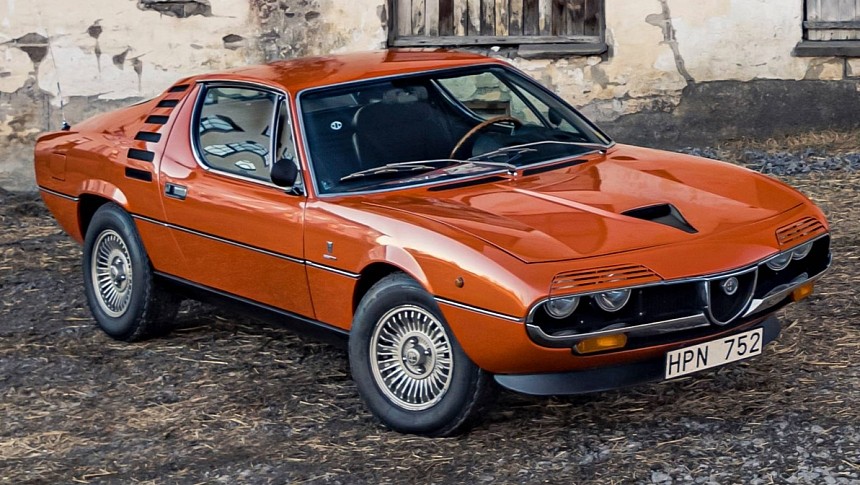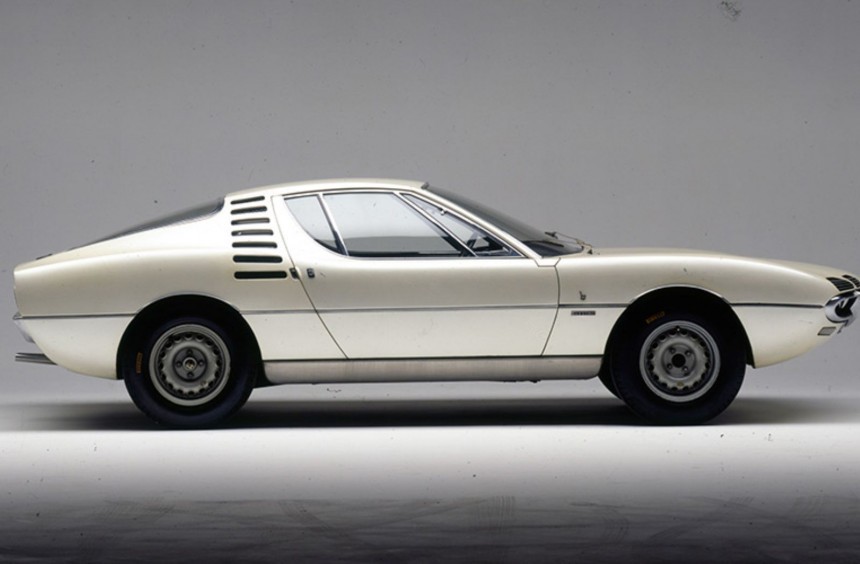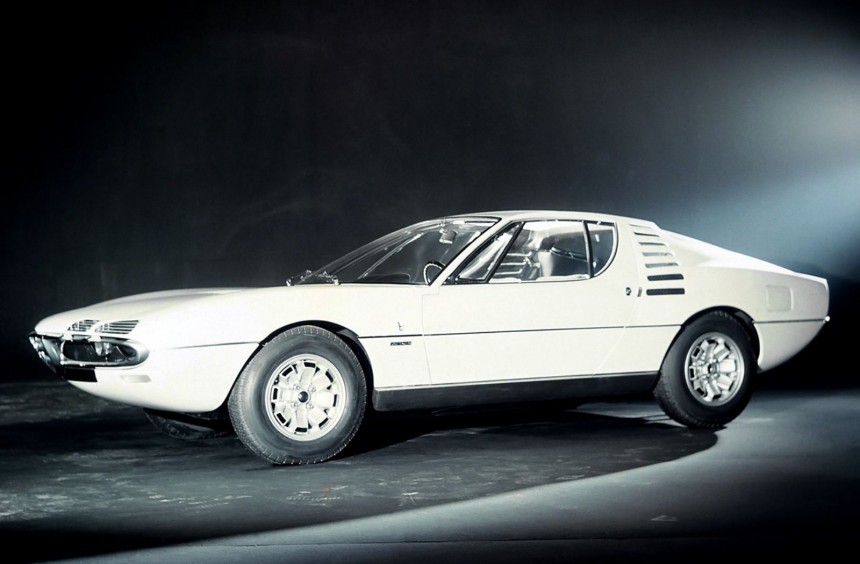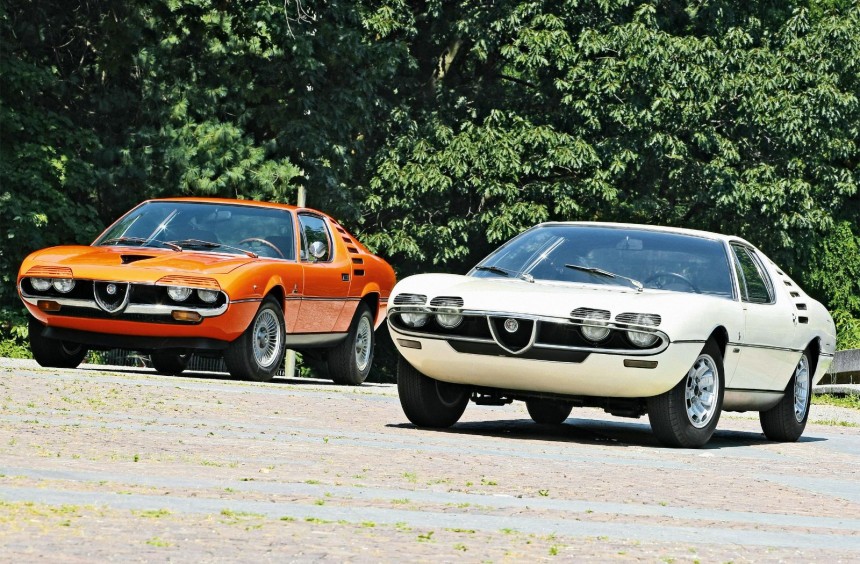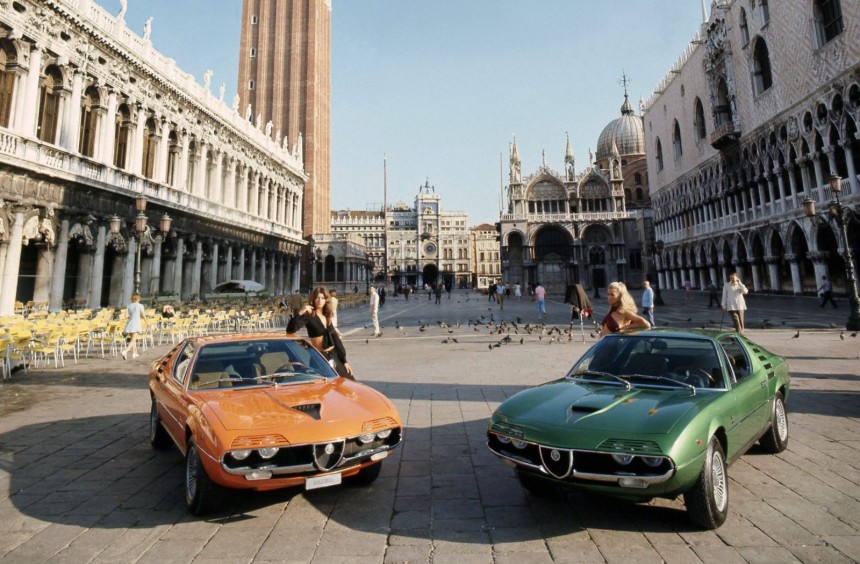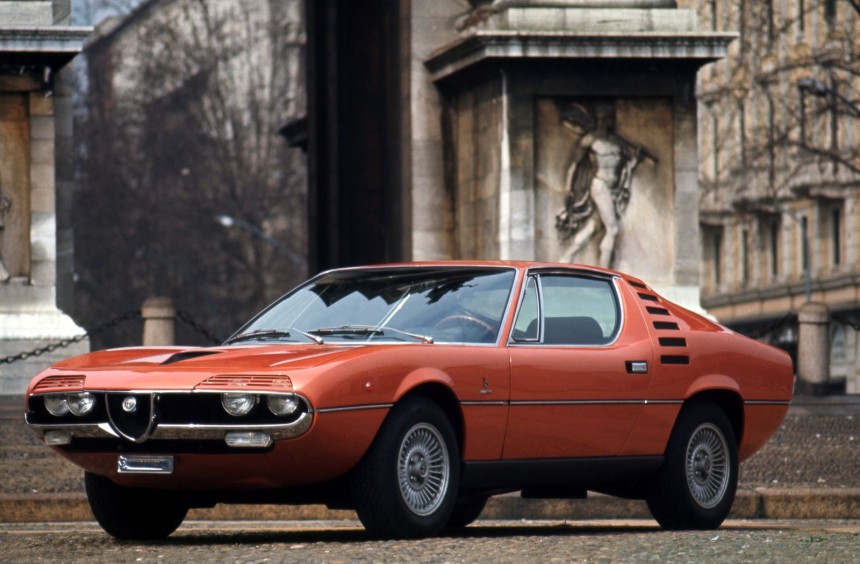Usually, show cars rarely make it into production, and when they do, the road-legal results are thoroughly watered-down. However, in the case of this 1970s Alfa Romeo, the production version became even better in terms of looks and performance.
The Alfa Romeo brand currently stands under the Stellantis corporate umbrella, trying to regain its identity. However, since it was established back in 1910 and up until the 1980s, when Fiat took over, Alfa was an independent manufacturer that played a massive role in motorsport and the evolution of road-legal sports cars.
Headquartered in Milan, Alfa Romeo was the carmaker where Italian automotive legends like Vittorio Jano, Orazio Satta Puliga, Giuseppe Busso, Carlo Chiti, and Giotto Bizzarrini started or took their careers to the next level. Enzo Ferrari is another legendary name tied to the brand. He began as a factory driver, then founded Scuderia Ferrari, which was initially an Alfa racing team.
Throughout its history as an independent manufacturer, Alfa Romeo amassed an extensive list of accomplishments in nearly all forms of motorsport. At the same time, its street cars were revered worldwide for their nearly-flawless handling and innovative engines.
In addition, some of the most extravagant show cars that ever came out of Italy donned Alfa Romeo badges. Most were designed by Bertone, the Turin-based design house and coachbuilder, who closely collaborated with the Milanese manufacturer for over three decades. One of these show cars developed during the late-1960s became one of the few which made it into production, and its exciting story deserves to be retold.
In 1967, Canada was celebrating its Centennial, and to mark the occasion, it hosted a vast world expo in Montreal, Quebec. One of the largest, most successful expos of the 20th century, it welcomed participants from 62 counties and saw more than 57 million visitors.
Near the expo entrance was a pavilion called "Man the Producer," showcasing the results of human imagination over the last century.
Naturally, the automobile was one of the stars of the pavilion. However, rather than displaying a historic vehicle like the Ford Model T, the organizers wanted a futuristic show car that was less a four-wheeled flying saucer and more of a functional concept that could be seen on the streets in the not-too-distant future.
Many established carmakers were invited to submit their proposals, but, in the end, two identical, white Alfa Romeo sports cars were featured at the event.
Like most of the Alfa concepts of that era, the cars were designed in Turin by Bertone. The young Marcelo Gandini was the stylist in charge of the project, which is why the overall shape of both concepts resembled a Lamborghini Miura. This supercar was also sketched by the famous designer about three years earlier.
Apart from the Miura-derived cues, such as the shape of the fastback-style body or side windows, the cars, which were put together in only nine months, shared elements from earlier Bertone designs. The slotted elements partially covering the headlights came from the Porsche 911 Spyder concept. At the same time, the imposing side vents were unquestionably inspired by the Alfa Romeo Canguro, albeit this time they were enlarged and placed on the C pillars rather than behind the front wheels.
Moreover, unlike the famous Lambo powered by a V12 placed in the middle of an advanced, semi-monocoque chassis, the fully-functional Alfa concepts were built around the underpinnings of the tiny Giulia Sprint GT. Moreover, both had a conventional, front-mounted 1.6-liter "Bialbero” four-cylinder borrowed from the Giulia 1600 TI that could only make 90 hp (91 ps).
The Expo 67 kicked off in April and ended in October. As I mentioned, over 57 million people attended the expo during those seven months. Many flocked to the "Man the Producer" pavilion, where the exhibit stars were the two examples of Alfa Romeo's yet-unnamed concept.
The manufacturer's officials who were present at the event were flooded with a multitude of questions about the concept, the most frequent being: "When will it be released?", "How much will it cost?" and "Will it have a V8"?
By the time the expo drew to a close, the car nicknamed Montreal by the visitors had become one of Alfa Romeo's most successful concepts. Although the idea of mass-producing never crossed the mind of anyone back in Milan when the expo started, the overwhelmingly positive response from the millions of Expo 67 attendees convinced management to develop a production version.
Like the concept cars, Bertone was commissioned to create the production version, and Marcelo Gandini was again in charge of the project. Rather than distilling the initial design, the stylist worked hard to improve and adapt it to comply with regulations from the world's most important markets.
Now built around the Giulia GTV chassis, the front and rear ends were reshaped, while the top of the wheel arches was slightly flared. Noticeable additions were slotted headlight covers that would now retract when the lights were turned on and a faux NACA duct fitted in the middle of the hood to conceal a bulge required by the new engine.
Speaking of the engine, the positive reaction from Expo 67 prompted Alfa Romeo decision-makers to consider exporting the production version to North America. But, to be successful in that all-important market, the car needed something better than the tiny four-cylinder, so Autodelta, the company's racing division, was called upon to develop one.
The engineering wizards didn't have the time or funds to build a powerplant from scratch, so they chose to adapt the 2.0-liter, twin-cam V8 previously used in the Tipo 33 prototype race car and its road-legal sibling, the gorgeous 33 Stradale. Enlarged to 2.6 liters, upgraded with fuel injection, and mated to a ZF five-speed manual, the dry-sump lubricated eight-cylinder was rated at 197 hp (200 ps) and 199 lb-ft (270 Nm) of torque.
Unveiled at the 1970 Geneva Motor Show and officially named Montreal, Alfa's new flagship retained the concept's most eye-catching features, was based on a better chassis, and came with a larger, more powerful, race-derived engine. Better than the initial concept in every way conceivable, the Alfa Romeo Montreal was (and still is) a rare example of a production version that not only matches, but exceeds the expectations outlined by the concept.
The development of the production version dragged on well into 1970, and while some customers in Italy received their examples that year, other European markets had to wait until 1971. By this time, the car didn't meet emission or safety regulations in the US, so it unfortunately never made it to North American shores.
Initially, both Bertone and Alfa wanted the concept to feature a mid-mounted engine, but there needed to be more time to develop a new chassis, so they opted for a conventional layout. The idea was again flirted with after the Montreal expo, but time and budget restraints made it impossible to implement. Even with the front-mounted engine, the production version became renowned for its lack of cargo space, minuscule rear seats that were grossly impractical, and poor rear visibility, problems usually associated with mid-engine sports cars.
On the positive side, the car measured up to the Alfa standards of highly controllable road manners; its race-derived V8 delivered 90% of the torque as early as 3,000 rpm while singing an addictive tune, whereas the five-speed gearbox was close to perfection.
Though only 3,925 units were ever built, Montreal survived as part of the Alfa Romeo lineup for seven straight years. Its imperfections gave it a distinct personality, and despite its exorbitant price tag, it developed a cult following among the Alfa faithful who still revere it today.
Had it been released two or three years earlier with its marvelous V8 mounted in the middle of the chassis, the Montreal could have been one of the most excellent sports cars of its era. Still, it remains a 1970s Alfa Romeo icon and a rare example of a production car that was better in every way than the concept it was based on.
You can see and hear this fantastic car prowling on the streets of New York in the Jay Leno's Garage episode below.
Headquartered in Milan, Alfa Romeo was the carmaker where Italian automotive legends like Vittorio Jano, Orazio Satta Puliga, Giuseppe Busso, Carlo Chiti, and Giotto Bizzarrini started or took their careers to the next level. Enzo Ferrari is another legendary name tied to the brand. He began as a factory driver, then founded Scuderia Ferrari, which was initially an Alfa racing team.
Throughout its history as an independent manufacturer, Alfa Romeo amassed an extensive list of accomplishments in nearly all forms of motorsport. At the same time, its street cars were revered worldwide for their nearly-flawless handling and innovative engines.
In addition, some of the most extravagant show cars that ever came out of Italy donned Alfa Romeo badges. Most were designed by Bertone, the Turin-based design house and coachbuilder, who closely collaborated with the Milanese manufacturer for over three decades. One of these show cars developed during the late-1960s became one of the few which made it into production, and its exciting story deserves to be retold.
The Expo 67 World's Fair
Near the expo entrance was a pavilion called "Man the Producer," showcasing the results of human imagination over the last century.
Naturally, the automobile was one of the stars of the pavilion. However, rather than displaying a historic vehicle like the Ford Model T, the organizers wanted a futuristic show car that was less a four-wheeled flying saucer and more of a functional concept that could be seen on the streets in the not-too-distant future.
Many established carmakers were invited to submit their proposals, but, in the end, two identical, white Alfa Romeo sports cars were featured at the event.
The "Montreal Expo" show cars
Apart from the Miura-derived cues, such as the shape of the fastback-style body or side windows, the cars, which were put together in only nine months, shared elements from earlier Bertone designs. The slotted elements partially covering the headlights came from the Porsche 911 Spyder concept. At the same time, the imposing side vents were unquestionably inspired by the Alfa Romeo Canguro, albeit this time they were enlarged and placed on the C pillars rather than behind the front wheels.
Moreover, unlike the famous Lambo powered by a V12 placed in the middle of an advanced, semi-monocoque chassis, the fully-functional Alfa concepts were built around the underpinnings of the tiny Giulia Sprint GT. Moreover, both had a conventional, front-mounted 1.6-liter "Bialbero” four-cylinder borrowed from the Giulia 1600 TI that could only make 90 hp (91 ps).
An overwhelmingly positive response
The manufacturer's officials who were present at the event were flooded with a multitude of questions about the concept, the most frequent being: "When will it be released?", "How much will it cost?" and "Will it have a V8"?
By the time the expo drew to a close, the car nicknamed Montreal by the visitors had become one of Alfa Romeo's most successful concepts. Although the idea of mass-producing never crossed the mind of anyone back in Milan when the expo started, the overwhelmingly positive response from the millions of Expo 67 attendees convinced management to develop a production version.
A rare example of a production car that was better than the concept
Now built around the Giulia GTV chassis, the front and rear ends were reshaped, while the top of the wheel arches was slightly flared. Noticeable additions were slotted headlight covers that would now retract when the lights were turned on and a faux NACA duct fitted in the middle of the hood to conceal a bulge required by the new engine.
Speaking of the engine, the positive reaction from Expo 67 prompted Alfa Romeo decision-makers to consider exporting the production version to North America. But, to be successful in that all-important market, the car needed something better than the tiny four-cylinder, so Autodelta, the company's racing division, was called upon to develop one.
The engineering wizards didn't have the time or funds to build a powerplant from scratch, so they chose to adapt the 2.0-liter, twin-cam V8 previously used in the Tipo 33 prototype race car and its road-legal sibling, the gorgeous 33 Stradale. Enlarged to 2.6 liters, upgraded with fuel injection, and mated to a ZF five-speed manual, the dry-sump lubricated eight-cylinder was rated at 197 hp (200 ps) and 199 lb-ft (270 Nm) of torque.
Unveiled at the 1970 Geneva Motor Show and officially named Montreal, Alfa's new flagship retained the concept's most eye-catching features, was based on a better chassis, and came with a larger, more powerful, race-derived engine. Better than the initial concept in every way conceivable, the Alfa Romeo Montreal was (and still is) a rare example of a production version that not only matches, but exceeds the expectations outlined by the concept.
It was never as remarkable as it could have been
Initially, both Bertone and Alfa wanted the concept to feature a mid-mounted engine, but there needed to be more time to develop a new chassis, so they opted for a conventional layout. The idea was again flirted with after the Montreal expo, but time and budget restraints made it impossible to implement. Even with the front-mounted engine, the production version became renowned for its lack of cargo space, minuscule rear seats that were grossly impractical, and poor rear visibility, problems usually associated with mid-engine sports cars.
On the positive side, the car measured up to the Alfa standards of highly controllable road manners; its race-derived V8 delivered 90% of the torque as early as 3,000 rpm while singing an addictive tune, whereas the five-speed gearbox was close to perfection.
Though only 3,925 units were ever built, Montreal survived as part of the Alfa Romeo lineup for seven straight years. Its imperfections gave it a distinct personality, and despite its exorbitant price tag, it developed a cult following among the Alfa faithful who still revere it today.
Had it been released two or three years earlier with its marvelous V8 mounted in the middle of the chassis, the Montreal could have been one of the most excellent sports cars of its era. Still, it remains a 1970s Alfa Romeo icon and a rare example of a production car that was better in every way than the concept it was based on.
You can see and hear this fantastic car prowling on the streets of New York in the Jay Leno's Garage episode below.
